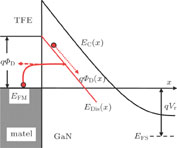† Corresponding author. E-mail:
In this work, a dislocation-related tunneling leakage current model is developed to explain the temperature-dependent reverse current–voltage (I–V–T) characteristics of a Schottky barrier diode fabricated on free-standing GaN substrate for reverse-bias voltages up to −150 V. The model suggests that the reverse leakage current is dominated by the direct tunneling of electrons from Schottky contact metal into a continuum of states associated with conductive dislocations in GaN epilayer. A reverse leakage current ideality factor, which originates from the scattering effect at metal/GaN interface, is introduced into the model. Good agreement between the experimental data and the simulated I–V curves is obtained.
Schottky contact on GaN is widely used as a fundamental building block of III-nitride-based power and optoelectronic device. However, excessive reverse-bias leakage current through metal/GaN Schottky contact is many orders of magnitude larger than the prediction of the thermionic emission theory,[1–3] even for the device fabricated on high-quality homoepitaxial n-GaN.[4,5] An investigation of the reverse leakage current mechanism is necessary for developing more effective methods to minimize reverse leakage current, especially under high reverse voltages.
By using conductive atomic force microscopy or other relevant characterization techniques, several research groups suggested that dislocations, especially those with a screw component, are the primary leakage path in GaN grown by molecular beam epitaxy,[6] metal-organic chemical vapor deposition,[7,8] and hydride vapor phase epitaxy (HVPE).[9] One of the topics under debate is the electron emission mechanism, namely how electrons overcome metal/GaN Schottky barrier and are injected into the dislocations. Zhang et al. [10] propounded that the electron emission mechanism is dominated by tunneling emission at low temperatures and by Frenkel–Poole thermal emission at high temperatures at reverse voltages ranging from 0 V to −8 V. Yet, a fitting electron effective mass of (3.4±0.3)×10−3 m e is derived from their fitting results at low temperatures while the well-accepted experimental electron effective mass is 0.222m e,[11] where m e is the electron mass. In addition, as far as we know, most research has concentrated on the cases at low reverse biases. Obviously, for power devices, it is necessary to study the reverse leakage mechanism at high reverse bias voltages.
In our previous work,[5] we proposed a dislocation-related tunneling model to explain the reverse leakage mechanism at reverse bias voltages up to – 20 V for a vertical Schottky barrier diode (SBD) on GaN homoepilayer. The model suggests that the leakage current through GaN Schottky contact is caused by electrons from the Schottky contact metal tunneling into a continuum of states associated with conductive dislocations in the Schottky barrier and then moving along the conductive dislocations.[5] In this work, the model is modified by introducing a reverse current ideality factor to explain the reverse leakage mechanism of Pt/n-GaN Schottky contact fabricated on free-standing GaN substrate for reverse-bias voltages up to −150 V at temperatures between 300 K and 450 K.
Figure
According to the dislocation-related tunneling model (as shown in Fig.
 | (1) |

 | Fig. 2. (color online) Energy band diagram showing the suggested dislocation-related tunneling model. |
However, the model mentioned above cannot fit the experimental reverse I–V –T curves shown in Fig.
The role of α is similar to the ideality factor for forward current. Thus, α is named the reverse current ideality factor. In the following, we will fit the experimental I–V –T curves by using Eq. (
The vertical SBD measured has a Schottky barrier height of 1.1 eV, and an n-type unintentional doping concentration N
D of 2.8 ×1016 cm−3.[4] The effective Richardson’s constant A
* extracted from the saturation current is 6.18 A ·cm−2
·K−2.[4] The dislocation density N
DD was not reported in Ref. [4]. By referring to Refs. [5] and [12], a value of ∼ 5 × 106 cm−2 is assigned to N
DD in our simulations. According to Eq. (
By taking qΦ
D and α as fitting parameters, we use Eq. (
 | Fig. 3. Fitted dislocation-related effective local barrier height qΦ D (a) and the reverse current ideality factor α (b) as a function of temperature. |
As shown in Fig.
We developed a modified dislocation-related tunneling model by introducing a reverse leakage current ideality factor to explain the reverse leakage current mechanism in Schottky contact fabricated on the bulk GaN substrate up to −150 V. The ideality factor originates from the carrier scattering effect at metal/GaN interface. Good agreement between the experimental data and the simulated I–V curves is obtained.
| [1] | |
| [2] | |
| [3] | |
| [4] | |
| [5] | |
| [6] | |
| [7] | |
| [8] | |
| [9] | |
| [10] | |
| [11] | |
| [12] | |
| [13] | |
| [14] | |
| [15] | |
| [16] | |
| [17] |



